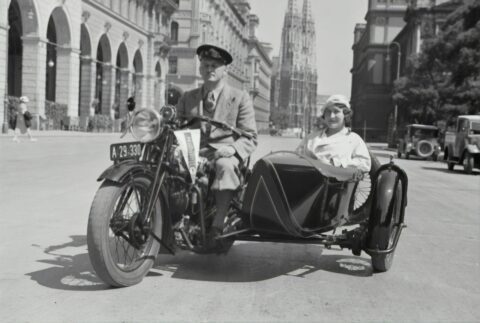Introduction to the History of Transportation
Revolutionary. Transformative. Life-changing. These are just a few words that come to mind when we think about the evolution of transportation throughout history. From the humble beginnings of horse-drawn carriages to the sleek and sustainable electric vehicles of today, our modes of getting from point A to point B have undergone remarkable transformations over time.
Join us on a journey through the annals of transportation history as we explore how innovation, invention, and sheer human ingenuity have shaped the way we move and connect with one another. Buckle up (pun intended), because this is going to be one wild ride! So let’s step into our time machine and travel back in time to where it all began: the rise of horse-drawn carriages.
The Rise of Horse-drawn Carriages
In the early days of transportation, when cars and trains were merely figments of imagination, horse-drawn carriages ruled the roads. These elegant vehicles were a symbol of wealth and prestige, often seen carrying aristocrats and nobles to their destinations.
The rise of horse-drawn carriages can be attributed to various factors. Horses were readily available and relatively easy to train compared to other animals. Their strength and agility made them an ideal choice for pulling heavy loads on both paved streets and rugged terrain.
As cities grew in size during the industrial revolution, horse-drawn carriages became essential for transporting goods and people. They played a vital role in connecting different parts of town, allowing businesses to thrive by facilitating trade.
Moreover, horse-drawn carriages provided a sense of luxury for those who could afford it. With ornate designs, plush interiors, and skilled drivers at the reins, these carriages offered a comfortable mode of transport that was envied by many.
However, as with any technology or mode of transport throughout history, there were drawbacks associated with horse-drawn carriages. The reliance on horses meant that travel distances were limited by how far they could go without rest or refreshment. Additionally, maintaining stables for these majestic creatures proved costly for carriage owners.
Despite its limitations though,the era of horse-drawn carriages laid the foundation for future advancements in transportation.
Mechanisms such as springs,wheels,and axles developed during this time continue to influence modern vehicle design till this day.
The rise of steam-powered trains marked another significant milestone in the evolution of transportation,further revolutionizing society’s ability to connect,distribute goods,and expand industry.
So next time you’re stuck behind slow-moving traffic,you can take comfort in knowing that our ancestors once relied on horsepower alone!
The Invention and Impact of Steam-powered Trains
Imagine a time when the world was not yet connected by high-speed trains and long-distance travel was a slow and arduous journey. This all changed with the invention of steam-powered trains, which revolutionized transportation in the 19th century.
Steam-powered trains, powered by coal-fired engines, brought about an unprecedented level of speed and efficiency to transportation. They allowed people to travel faster than ever before, opening up new opportunities for trade, tourism, and exploration. With their ability to transport goods and people over great distances at relatively high speeds, steam-powered trains played a pivotal role in shaping modern society.
The impact of steam-powered trains extended beyond just transportation. They facilitated the growth of industries such as mining, manufacturing, and agriculture by providing a reliable means of transporting raw materials and finished products across vast distances. The railways also stimulated urbanization as cities grew around train stations.
Furthermore, steam-powered trains had profound social implications. They enabled individuals to explore distant lands more easily while bringing different cultures together through enhanced communication and cultural exchange.
However revolutionary they were during their time, steam-powered trains eventually gave way to more advanced forms of transport such as diesel locomotives and electric trains. Nonetheless, their legacy is undeniable – they provided the foundation for modern rail systems that continue to play an essential role in our global economy today.
So next time you hop on board a sleek bullet train or enjoy your commute on an efficient subway system think back to those early days when steam power transformed the world’s concept of transportation forever!
The Automobile Revolution and its Effects on Society
The Automobile Revolution and its Effects on Society
When automobiles burst onto the scene in the late 19th century, they brought with them a wave of innovation that forever transformed society. No longer were people confined to the limitations of horse-drawn carriages or reliant on unreliable public transportation.
With cars, individuals gained a newfound sense of freedom and mobility. They could travel greater distances in shorter amounts of time, opening up opportunities for exploration and adventure. Commuting to work became easier, making it possible for people to live farther away from their jobs and expand into suburban areas.
Not only did automobiles change how people traveled, but they also had a profound impact on industries such as manufacturing, tourism, and commerce. With increased accessibility came increased demand for goods and services. Roads needed to be built and maintained, gas stations sprang up along highways, hotels flourished near popular destinations – all due to the rise of automobile culture.
Of course, with progress comes challenges. The rapid growth in car ownership led to issues like traffic congestion and pollution. As more vehicles hit the roads, cities struggled to keep up with infrastructure demands. Traffic jams became a common frustration that city planners had to address through better road design and public transit options.
However, despite these challenges, automobiles have undeniably shaped modern society in positive ways as well. They have connected communities across vast distances while also providing individualized transportation at our fingertips.
Today’s cars continue evolving with advancements in technology such as electric powertrains and autonomous driving capabilities that promise even greater benefits for both individuals and the environment.
In conclusion: The automobile revolution has undoubtedly transformed society by granting us unprecedented freedom of movement while presenting new challenges that we must overcome for sustainable transportation solutions moving forward
The Emergence of Electric Vehicles and their Environmental Benefits
The Emergence of Electric Vehicles and their Environmental Benefits
As we continue our journey exploring the evolution of transportation, it’s impossible not to mention the emergence of electric vehicles (EVs) and their significant environmental benefits. In recent years, EVs have gained immense popularity due to advancements in technology and increased awareness about the importance of sustainable transportation.
One key advantage of electric vehicles is that they produce zero tailpipe emissions. Unlike traditional gasoline-powered cars that release harmful pollutants into the air, EVs operate solely on electricity stored in batteries. This means cleaner air for us to breathe and a reduced carbon footprint for our planet.
Moreover, electric vehicles are much more energy-efficient compared to internal combustion engine vehicles. While conventional cars waste a significant amount of energy through heat dissipation, EVs convert almost 90% of electrical energy from the grid directly into power at the wheels. This efficiency not only saves money but also reduces dependence on fossil fuels.
In addition to being environmentally friendly, electric vehicles offer several other benefits. They require less maintenance as they have fewer moving parts than traditional cars. With no need for oil changes or regular tune-ups, owners can save both time and money on servicing their vehicles.
Furthermore, governments around the world are promoting the adoption of electric vehicles by offering incentives such as tax credits or rebates for purchasing them. These initiatives aim to accelerate the transition towards greener transportation options and reduce greenhouse gas emissions overall.
It’s important to acknowledge that there are still challenges associated with widespread adoption of electric vehicles such as limited charging infrastructure and higher upfront costs compared to gasoline-powered cars. However, continuous technological advancements combined with increasing public demand will likely address these obstacles in due course.
In conclusion (as per your instruction), electric vehicles have emerged as an exciting alternative in modern transportation systems due to their numerous environmental benefits including zero tailpipe emissions and high energy efficiency rates. As we move forward into a more sustainable future, it is likely that electric vehicles will play a significant role in reducing our carbon footprint and preserving
Challenges and Advancements in Modern Transportation Systems
Challenges and Advancements in Modern Transportation Systems
As society continues to evolve, so too does our need for efficient and sustainable transportation systems. However, modern transportation also comes with its fair share of challenges. One such challenge is the ever-increasing traffic congestion in urban areas. With more cars on the road than ever before, finding ways to alleviate this congestion has become a top priority.
To address this issue, many cities have implemented smart traffic management systems that use real-time data and advanced algorithms to optimize traffic flow. These systems can adjust signal timings based on current conditions and even detect accidents or road hazards to reroute traffic accordingly.
Another challenge facing modern transportation is the environmental impact of traditional fuel-powered vehicles. The burning of fossil fuels contributes significantly to air pollution and greenhouse gas emissions, leading to climate change.
To combat this issue, there has been a growing interest in electric vehicles (EVs). EVs produce zero tailpipe emissions and can be powered by renewable energy sources like wind or solar power. As battery technology continues to improve, EVs are becoming more affordable and capable of longer trips between charges.
Advancements in autonomous vehicle technology are also shaping the future of transportation. Self-driving cars have the potential to reduce accidents caused by human error while improving overall efficiency on the roads.
Additionally, ride-sharing services like Uber and Lyft have revolutionized urban mobility by providing convenient alternatives to traditional car ownership. This shift towards shared mobility not only reduces congestion but also decreases parking demands in crowded city centers.
Furthermore, advancements in high-speed rail systems offer an alternative mode of travel that is faster than driving but less carbon-intensive than flying. Countries like Japan and China have already implemented bullet train networks that connect major cities efficiently.
In conclusion,
Modern transportation systems face numerous challenges as they strive for efficiency, sustainability, and safety. However, advancements such as smart traffic management systems, electric vehicles,
autonomous vehicles,
ride-sharing services,
and high-speed rail systems are helping to address these challenges and shape the future of transportation.
Conclusion: What’s Next for the Future of Transportation?
As we reflect on the incredible journey of transportation throughout history, it’s clear that we have come a long way from horse-drawn carriages to electric vehicles. The evolution of transportation has not only revolutionized the way we travel but has also shaped our societies and economies.
Looking ahead, what does the future hold for transportation? With advancements in technology and increasing concerns about climate change, there are exciting developments on the horizon. Here are some possibilities for the future of transportation:
1. Autonomous Vehicles: Self-driving cars have already made their debut on our roads, and they continue to improve with each passing year. In the near future, we may see fully autonomous vehicles becoming a common sight, offering increased safety and efficiency in our daily commutes.
2. Hyperloop Systems: Imagine traveling at speeds exceeding 700 miles per hour in a vacuum-sealed tube! Hyperloop technology holds great promise for ultra-fast and energy-efficient transport between cities or even countries.
3. Electric Aviation: As electric vehicle technology continues to advance rapidly, it is only natural that aviation will follow suit. Electric planes could significantly reduce carbon emissions from air travel and make flying more sustainable.
4. Sustainable Infrastructure: The development of greener infrastructure will play a crucial role in shaping the future of transportation. Investments in charging stations for electric vehicles, bike lanes, pedestrian-friendly streetscapes, and efficient public transport systems will lead us towards cleaner and more accessible urban mobility.
5. Drones for Delivery Services: Unmanned aerial vehicles (UAVs) or drones have already proven their potential as delivery tools by companies like Amazon. In the coming years, drone delivery services may become widespread across various industries such as e-commerce and healthcare.
6.
Space Tourism: While still in its infancy stages today with private space companies like SpaceX leading the charge – space tourism could become a reality within our lifetime! This would offer an entirely new perspective on travel beyond Earth’s boundaries.
The future of transportation is undoubtedly exciting, with countless possibilities and innovations waiting to







